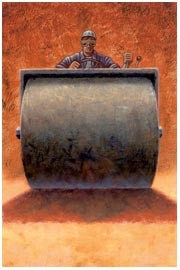- Select a language for the TTS:
- UK English Female
- UK English Male
- US English Female
- US English Male
- Australian Female
- Australian Male
- Language selected: (auto detect) - EN
Play all audios:
Thailand’s government expects its portion of a high-speed railway that will connect it with China through Laos to begin operations by the end of the decade, despite sluggish progress since
construction began in 2017. The construction of the first phase of the line linking Bangkok and Nakhon Ratchasima province is currently about 36 percent complete, government spokesman Jirayu
Houngsub said in a statement yesterday, the Bangkok Post reported. The design for the second phase that will extend the rail line to Nong Khai on the border with Laos has been finalized and
is ready to be submitted to the cabinet for approval, Jirayu said. He added that the first phase is on track for completion by 2027 and the entire 609-kilometer line by 2030. Jiraya added
that the completion of the rail line, which is estimated to cost 434 billion baht ($12.9 billion), will be “an opportunity for Thailand to connect to the global economy” and underscore its
status as a regional logistics hub. The proposed rail link will run Bangkok to the Nong Khai on the border with Laos, where it will connect to the China-Laos Railway, a flagship project of
China’s Belt and Road Initiative (BRI), which began operations in late 2021. When the link is completed, it will be possible to travel by train from Bangkok to Kunming, the capital of
China’s Yunnan province, and from there to the rest of China via the country’s extensive high-speed rail network. Discussions on the Thailand high-speed line started nearly two decades ago,
and the project was formally initiated in 2014. Construction then began in December 2017 on the Bangkok-Nakhon Ratchasima leg of the project. However, progress has been sluggish due to
disagreements on cost and loan terms, the COVID-19 pandemic, and challenges related to land development rights. Just last month, the board of the State Railway of Thailand approved the
extension of contracts for three segments of the rail line by up to two years, citing difficulties from land expropriation and the relocation of oil pipelines along its route. The slow
progress has reportedly been a subject of frustration in Beijing. During a visit to Bangkok in January of last year, Chinese Foreign Minister Wang Yi called for China and Thailand to
expedite the construction of the rail line and “open the central line of the Trans-Asian Railway.” Like other planned high-speed railway lines connecting Yunnan province with Myanmar and
Vietnam, the line through Thailand and Laos is intended to deepen the economic integration between mainland Southeast Asia and southern China, which has historically been inhibited by the
rugged and heavily forested terrain. Since taking office in 2023, the Pheu Thai-led government has promised to speed up the completion of the railway project, which chimes with its goals of
attracting more trade and tourism from China and positioning itself as the “logistics hub of Asia.” Speaking to the press yesterday, spokesperson Jirayu said that Prime Minister Paetongtarn
Shinawatra has ordered the expedition of the high-speed rail project, along with separate projects to double the track of some of Thailand’s existing railway lines and construct a “land
bridge” across the Isthmus of Kra in the south of the country. Given the repeated postponements that have attended the first eight years of the project’s construction – in late 2023, the
Thai government was projecting that the project would be completed by 2028 – it is right to regard the 2030 deadline with a degree of skepticism, even if the railway line is eventually
built.






